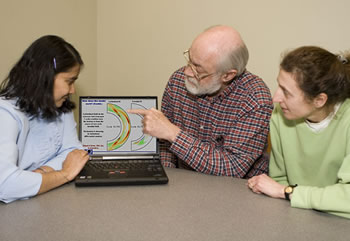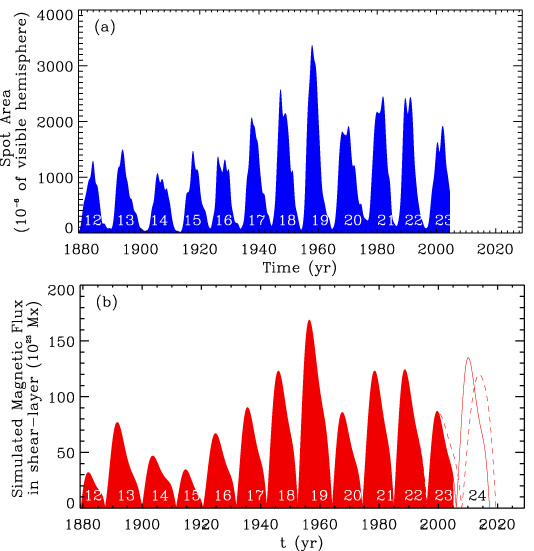Scientists Issue Unprecedented Forecast of Next Sunspot Cycle
Boulder - The next sunspot cycle will be 30-50% stronger than the last one and begin as much as a year late, according to a breakthrough forecast using a computer model of solar dynamics developed by scientists at the National Center for Atmospheric Research (NCAR). Predicting the Sun's cycles accurately, years in advance, will help societies plan for active bouts of solar storms, which can slow satellite orbits, disrupt communications, and bring down power systems.
The scientists have confidence in the forecast because, in a series of test runs, the newly developed model simulated the strength of the past eight solar cycles with more than 98% accuracy. The forecasts are generated, in part, by tracking the subsurface movements of the sunspot remnants of the previous two solar cycles. The team is publishing its forecast in the current issue of Geophysical Research Letters.
"Our model has demonstrated the necessary skill to be used as a forecasting tool," says NCAR scientist Mausumi Dikpati, the leader of the forecast team at NCAR's High Altitude Observatory that also includes Peter Gilman and Giuliana de Toma.
Understanding the cycles
The Sun goes through approximately 11-year cycles, from peak storm activity to quiet and back again. Solar scientists have tracked them for some time without being able to predict their relative intensity or timing.

Forecasting the cycle may help society anticipate solar storms, which can disrupt communications and power systems and affect the orbits of satellites. The storms are linked to twisted magnetic fields in the Sun that suddenly snap and release tremendous amounts of energy. They tend to occur near dark regions of concentrated magnetic fields, known as sunspots.
The NCAR team's computer model, known as the Predictive Flux-transport Dynamo Model, draws on research by NCAR scientists indicating that the evolution of sunspots is caused by a current of plasma, or electrified gas, that circulates between the Sun's equator and its poles over a period of 17 to 22 years. This current acts like a conveyor belt of sunspots.
The sunspot process begins with tightly concentrated magnetic field lines in the solar convection zone (the outermost layer of the Sun's interior). The field lines rise to the surface at low latitudes and form bipolar sunspots, which are regions of concentrated magnetic fields. When these sunspots decay, they imprint the moving plasma with a type of magnetic signature. As the plasma nears the poles, it sinks about 200,000 kilometers (124,000 miles) back into the convection zone and starts returning toward the equator at a speed of about one meter (three feet) per second or slower. The increasingly concentrated fields become stretched and twisted by the internal rotation of the Sun as they near the equator, gradually becoming less stable than the surrounding plasma. This eventually causes coiled-up magnetic field lines to rise up, tear through the Sun's surface, and create new sunspots.
The subsurface plasma flow used in the model has been verified with the relatively new technique of helioseismology, based on observations from both NSF - and NASA - supported instruments. This technique tracks sound waves reverberating inside the Sun to reveal details about the interior, much as a doctor might use an ultrasound to see inside a patient.

Predicting Cycles 24 and 25
The Predictive Flux-transport Dynamo Model is enabling NCAR scientists to predict that the next solar cycle, known as Cycle 24, will produce sunspots across an area slightly larger than 2.5% of the visible surface of the Sun. The scientists expect the cycle to begin in late 2007 or early 2008, which is about 6 to 12 months later than a cycle would normally start. Cycle 24 is likely to reach its peak about 2012.
Comment: It is now June 2009 and it still has not started.
By analyzing recent solar cycles, the scientists also hope to forecast sunspot activity two solar cycles, or 22 years, into the future. The NCAR team is planning in the next year to issue a forecast of Cycle 25, which will peak in the early 2020s.
"This is a significant breakthrough with important applications, especially for satellite-dependent sectors of society," explains NCAR scientist Peter Gilman.
The NCAR team received funding from the National Science Foundation and NASA's Living with a Star program.
Important Note:
The date of this NCAR News Release is March 6, 2006.
Source: Link



Comment: Computer models with a 98% accuracy fail to forecast reality. The IPCC global warming computer models cannot reproduce any historical climatic history. The IPCC computer models cannot model oceanic thermal oscillations, volcanic activity, total solar irradiance, cosmic radiation flux, cloud cover, or much else that is vital to understanding climate science, forward or backward in time. Yet the global psychological machine is ready to impose controls on the entire population of the world that may kill millions and millions of people by denying them heat and fuel and food and jobs.
Why are these intimidators not equated as terrorists? They incite catastrophic fear in the population. They bully and intimidate other scientists. They demean and slander. They spin derogatory language to dehumanize those who try to speak up and show their reasoning is falsifiable if not down right lies in some cases. And the media such as is displayed in the above article is their willing accomplice, their tool.
We live in an insane world run by psychologically compromised minds.